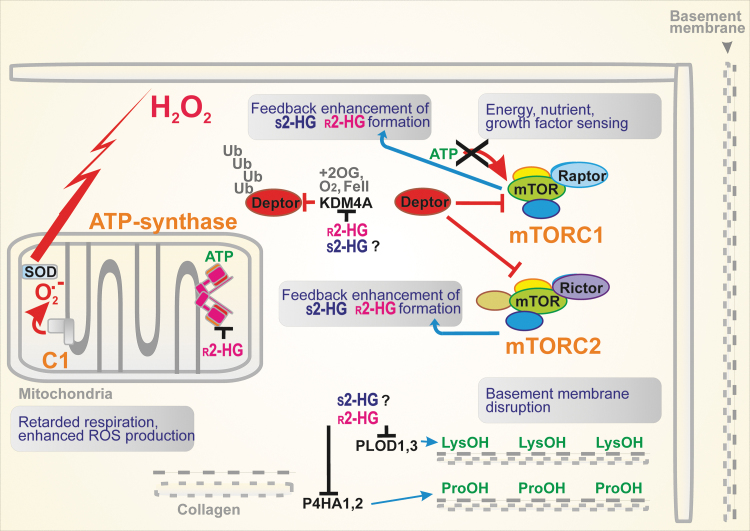FIG. 5.
2HG interference with the mTOR pathway and collagen maturation. Since the 2OG-dependent dioxygenase KDM4A stabilizes DEPTOR, the endogenous negative regulator of mTOR, and since the 2HG-mediated inhibition of KDM4A releases DEPTOR by preventing its polyubiquitylation, the activation of both mTORC1 and mTORC2 is prevented. Consequently, the mTOR pathway is blocked. Otherwise, the activation of the mTOR pathway promotes cell proliferation and survival and consequently carcinogenesis. Since r-2HG inhibits KDM4A, DEPTOR is degraded and mTORC1/2 is activated, this inhibition causes an enhancement of carcinogenesis. Alternatively, since r-2HG was found to inhibit the ATP-synthase in Caenorhabditis elegans, supposing that this also proceeds with human ATP-synthase, one can also predict the activation of mTOR by the decreased ATP. This inhibition also contributes to higher mitochondrial superoxide formation. Since other 2OG-dependent enzymes participate in collagen maturation, this is also affected by r-2HG. Thus, procollagen-lysine 2-oxoglutarate 5-dioxygenase PLOD1 and PLOD3 and prolyl 4-hydroxylase P4HA1 and PHA3 stabilize the triple helix of collagen via the respective hydroxylations. Consequently, the inhibitory r-2HG blocks the maturation of collagen and disrupts the stability of the basement membrane, thus promoting tumor growth and metastases invasion. DEPTOR, DEP domain-containing mTOR-interacting protein; mTOR, mammalian target of rapamycin.

